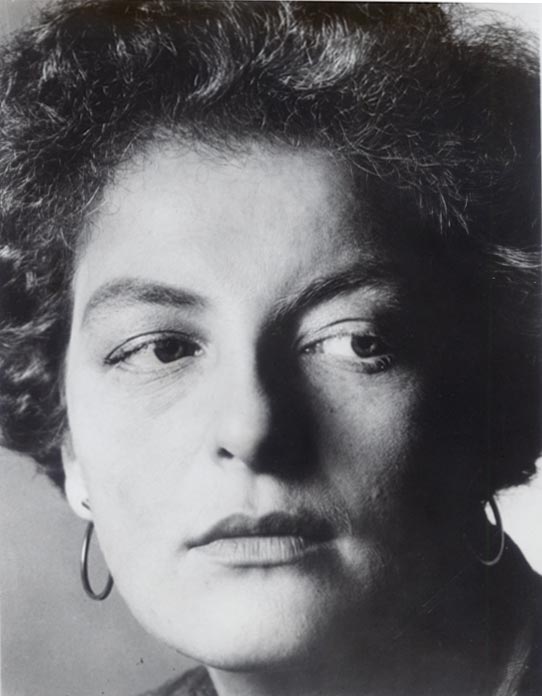78. Rachel Rosenthal
| Life Dates | 1926-2015 |
| Place of Birth | Paris, France |
| Place of Death | Los Angeles, CA, USA |
| Birth Name | Rachel Rosenthal |
Rachel Rosenthal was born in Paris, France, to Russian Jewish parents. Her father, Leonard, had lived in France since the late 1880s and built a very successful jewelry business selling precious stones and pearls, and her mother, Mara, displaced because of the Bolshevik Revolution, met Leonard through his philanthropy towards Russian émigrés. The family fled France in June 1940, right before the Germans invaded, and made their way to New York City via stopovers in Portugal and Brazil. Arriving in spring 1941, Rosenthal enrolled at the High School of Music & Art, already demonstrating strong creative talents as a teenager. She graduated just as the war ended and studied soon thereafter at Hans Hofmann’s studio and at the New School for Social Research with Meyer Schapiro and Rudolf Arnheim.1 Over the next eight years, she divided her time between New York and France, not feeling quite at home in either place. During her travels, she befriended some major figures of the postwar avant-garde—Merce Cunningham, John Cage, Jasper Johns, Robert Rauschenberg—and decided to remain in New York which was fast becoming the center of the art world. In the early 1950s, Rosenthal found her way to Atelier 17, likely through the influence of Sari Dienes, another friend who was highly networked into this same group of experimental artists, musicians, and performers. She appears in the Grippe student ledger book for March 1954, though it is possible she was affiliated with Atelier 17 at an earlier point.2 A group of roughly six engravings recently unearthed from the artist’s archives, demonstrate her competence with the engraver’s burin and using printmaking as a vehicle for self expression.3 At the printmaking workshop, she remembers first encountering Miriam Schapiro, whom she would interface with again very substantially through both women’s feminist activism in Southern California during the early 1970s. By that point, Rosenthal had developed a unique form of performance art, for which she is best known today.
Notes
- Unless otherwise noted, biographical details come from Moira Roth, ed., Rachel Rosenthal (Baltimore: Johns Hopkins University Press, 1997), 205–6. ↩
- In her oral history with Moira Roth, Rosenthal states that she met Miriam Schapiro at Atelier 17 in the late 1940s. This timing, however, does not coordinate with Schapiro’s biography. Shapiro and her husband Paul Brach only moved to New York City in the early 1950s from Columbia, Missouri, where he had been teaching. Instead of the late 1940s, Rosenthal and Schapiro likely overlapped at Atelier 17 in 1951 or 1952, before Peter Grippe’s directorship. Grippe and his wife Florence were meticulous record keepers, and Schapiro does not appear in the Grippes’s student ledger book, as Rosenthal does. All of this does not preclude Rosenthal’s earlier involvement with Atelier 17. Given her immediate post-high school study with Hans Hofmann and at the New School for Social Research, it is possible she also attended Atelier 17 in the mid- to late-1940s. See Rachel Rosenthal, oral history with Moira Roth, September 2, 1989, Archives of American Art, Smithsonian Institution; and chronology in Roth, 205–6. ↩
- Kate Noonan, Director of the Rachel Rosenthal Company, found these prints in the artist’s archives in a folder marked as correspondence. Rosenthal also had exchange prints from Stanley William Hayter, Pierre Courtin, Terry Haass, and Wilfredo Lam. The prints were exhibited in “Rachel Rosenthal: Early Works on Paper,” Craig Krull Gallery, Santa Monica, California (June 1 to June 13, 2019). ↩


